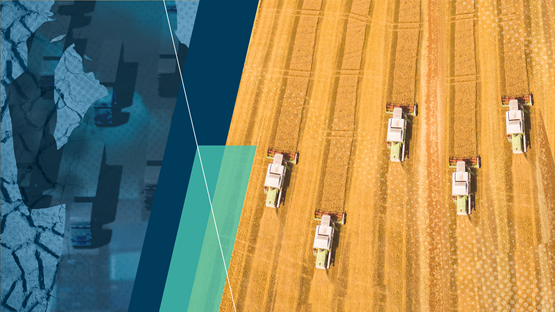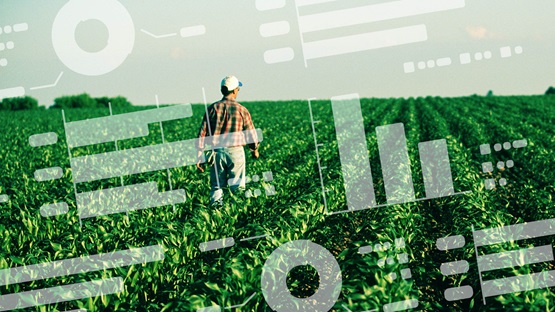A year into a tenuous recovery in agriculture driven as much by government support as by market conditions, widespread and severe drought could be expected to be a major setback. And while that drought was indeed a harsh blow to producers in the worst-hit regions, continued strong commodity prices along with timely rains in other areas softened the impact, according to the Federal Reserve Bank of Minneapolis’ third-quarter agricultural credit conditions survey conducted in October.
Farm incomes across the Ninth District continued to increase from July through September 2021 relative to the same period a year earlier, according to most lenders surveyed. Spending on capital equipment and farm household purchases also increased on balance. Loan demand decreased, while incomes supported a higher rate of loan repayment, and renewals and extensions largely held steady. Land values and cash rents jumped across district states, and interest rates on loans generally ticked down slightly further from the previous quarter. Despite drought impacts, the outlook for the fourth quarter is moderately optimistic, with lenders in the district generally expecting farm incomes to increase.
Farm income, household spending, and capital investment
Several commenters noted that as a result of supply-chain disruptions, “high input costs are a concern,” as a South Dakota respondent noted. Still, on balance, crop prices were driving income growth, as 71 percent of district lenders surveyed in the third quarter said incomes increased from a year earlier, while another 21 percent reported no change (see chart). Regarding spending by farm households, a roughly even proportion reported that it increased as reported no change. The breakdown for capital spending was similar, with a slightly higher proportion reporting increased spending on buildings and equipment than reporting steady spending from a year ago.
Drought impacts
The October survey asked lenders a special question about the effects on farm finances of the worst drought the district has seen in more than 30 years. Most lenders—57 percent—reported that the drought had a “modest negative impact,” with an additional 21 percent reporting a severe negative impact. A modest or significantly positive impact was reported by 13 percent of survey respondents, with 9 percent reporting no impact.
Comments on the survey also reflected this story, though several noted that the overall impact of drought was still unknown at the time of the survey. Livestock producers suffered the worst impacts of drought because of its effects on hay availability, leading a South Dakota banker to predict, “We will see cattle numbers down because of the drought.” Others reported that producers were cutting corn for silage due to lack of hay. Regionally, the effects varied greatly, with the hardest-hit parts of Montana and North Dakota suffering the worst, while respondents in much of Minnesota and Wisconsin noted that crops fared better than expected. But even in one of the driest parts of North Dakota, a lender commented, “We are harvesting an above-to-average crop with better than average prices; for the most part, our farmers are having a good year.”
Loan repayments and renewals
The rate of repayment on agricultural loans increased on balance, reflecting continued improvement in farm finances, while renewals largely held steady. Loan repayments were unchanged from a year earlier according to 53 percent of respondents, while 45 percent reported that repayment rates increased. Two-thirds of lenders stated that the number of renewals or extensions was unchanged, while a quarter said renewal activity was down. No banks reported having refused a loan due to a shortage of funds.
Demand for loans, required collateral, and interest rates
Demand for loans decreased on balance, according to lenders, with 43 percent reporting lower loan demand relative to a year ago. By contrast, 17 percent noted increased loan demand. Collateral requirements on loans were unchanged, according to 94 percent of lenders surveyed, with the balance reporting increases in collateral requirements. Interest rates for most loan categories continued to decrease, with the sole exception of variable-rate operating loans, which increased slightly from the previous quarter.
Cash rents and land values
Land values and cash rents jumped again in the third quarter after growing strongly in the previous survey. Ninth District nonirrigated cropland values increased by 22 percent on average from the third quarter of 2021. Values for nonirrigated land increased by nearly 14 percent, while ranch- and pastureland values increased about 6 percent. Land rents followed suit, as the district average cash rent for nonirrigated land increased by 12 percent from a year ago. Rents for irrigated land grew by 8 percent, while ranchland rents jumped 13 percent. Changes in land values and rents were generally consistent across district states.
Outlook
“With the improved profits, I expect many of my customers to start upgrading equipment,” reported a banker in Minnesota. Those expectations appeared to be shared widely, as 58 percent of survey respondents expected farm capital spending to increase in the final three months of 2021. Across the district, two-thirds of lenders expected farm incomes to increase in the fourth quarter, compared with 13 percent who expected decreased incomes. The forecast for capital spending was up as well, with 49 percent of respondents expecting increases and 45 percent expecting no change.
Perhaps in expectation of that spending, more than a third of respondents projected demand for loans to increase in the final three months of 2021, while 19 percent expected decreased loan demand. Nearly all lenders anticipate loan repayment rates to increase or hold steady, and two-thirds expected increased renewals and extensions.
| MN | MT | ND | SD | WI | Ninth District | |
|---|---|---|---|---|---|---|
| Percent of respondents who reported decreased levels for the past three months compared with the same period last year: | ||||||
| Rate of loan repayments | – | – | – | 7 | – | 2 |
| Net farm income | 5 | – | 27 | – | – | 8 |
| Farm household spending | – | – | 27 | – | – | 6 |
| Farm capital spending | 5 | 25 | 36 | – | – | 10 |
| Loan demand | 35 | 25 | 27 | 67 | 67 | 43 |
| Percent of respondents who reported increased levels for the past three months compared with the same period last year: | ||||||
| Loan renewals or extensions | – | – | 27 | – | 33 | 8 |
| Referrals to other lenders | – | 25 | – | – | – | 2 |
| Amount of collateral required | – | 25 | 9 | 8 | – | 6 |
| Loan demand | 30 | 25 | 18 | – | – | 17 |
| MN | MT | ND | SD | WI | Ninth District | |
|---|---|---|---|---|---|---|
| Percent of respondents who expect decreased levels for the next three months: | ||||||
| Rate of loan repayments | 5 | – | – | 7 | – | 4 |
| Net farm income | 5 | 25 | 18 | 20 | – | 13 |
| Farm household spending | – | 25 | 18 | – | – | 6 |
| Farm capital spending | 5 | 25 | 27 | 7 | – | 11 |
| Loan demand | 25 | – | 9 | 20 | 33 | 19 |
| Percent of respondents who expect increased levels for the next three months: | ||||||
| Loan renewals or extensions | 25 | 25 | 18 | 7 | 33 | 19 |
| Referrals to other lenders | – | 25 | – | – | – | 2 |
| Amount of collateral required | – | 25 | 9 | 7 | – | 6 |
| Loan demand | 50 | 25 | 27 | 27 | 67 | 38 |
| Operating | Machinery | Real Estate | |||||
|---|---|---|---|---|---|---|---|
| Fixed | Var. | Fixed | Var. | Fixed | Var. | ||
| Q4-19 | January | 5.8 | 5.7 | 5.7 | 5.6 | 5.5 | 5.3 |
| Q1-20 | April | 5.3 | 5.1 | 5.2 | 5.1 | 4.9 | 4.8 |
| Q2-20 | July | 5.1 | 4.9 | 5.0 | 4.8 | 4.8 | 4.6 |
| Q3-20 | October | 5.0 | 4.8 | 4.8 | 4.8 | 4.6 | 4.5 |
| Q4-20 | January | 4.9 | 4.8 | 4.8 | 4.7 | 4.4 | 4.3 |
| Q1-21 | April | 4.7 | 4.5 | 4.6 | 4.4 | 4.4 | 4.2 |
| Q2-21 | July | 4.7 | 4.5 | 4.5 | 4.4 | 4.3 | 4.1 |
| Q3-21 | October | 4.6 | 4.5 | 4.4 | 4.3 | 4.2 | 4.1 |
Joe Mahon is a Minneapolis Fed regional outreach director. Joe’s primary responsibilities involve tracking several sectors of the Ninth District economy, including agriculture, manufacturing, energy, and mining.





